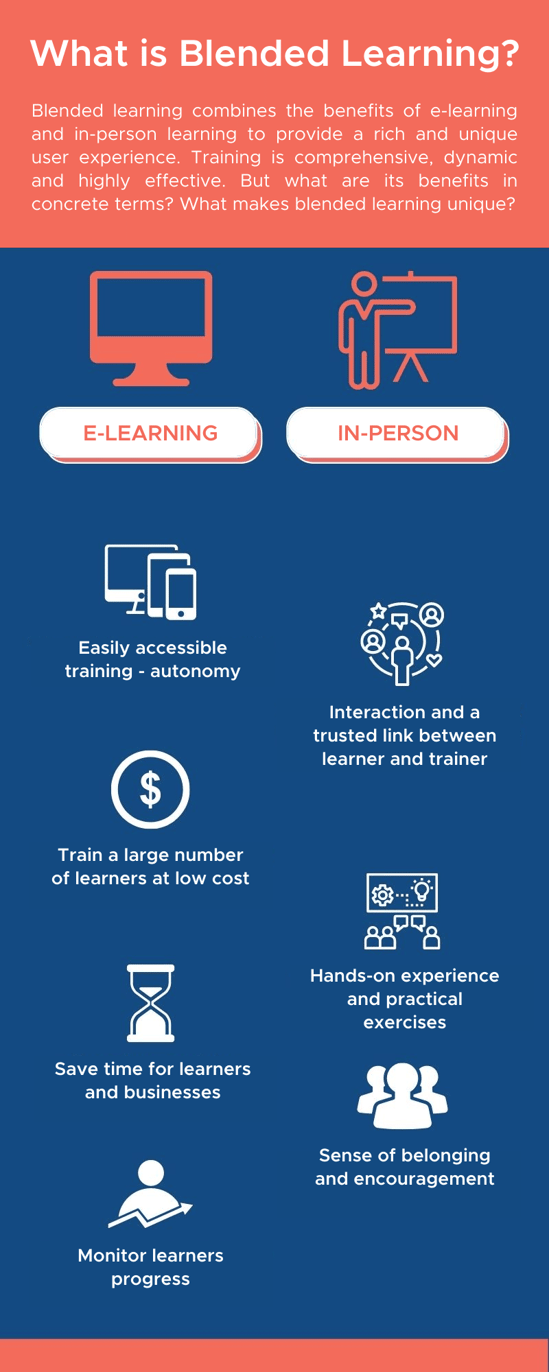8 Minutes of reading
What is Blended Learning? What does Blended Learning mean?
You might have heard about blended learning: professional training experts rave about it, and it has featured on the agenda of every digital transformation conference for some time. But, what does blended learning actually mean? Want to know what all the hype’s about and the answers to the question, what is blended learning? We’ve produced a handy infographic to help explain.

What does blended learning mean?
What better way to explain the complexity of blended learning than by using an infographic? The infographic outlines when we talk about “what does blended learning mean”, we are referring to the combination of e--learning and in-person learning. This provides an optimized training solution by blending the advantages of both types of learning into one package.

As you can see, the combination of the two learning methods allows for a fully customized, interactive solution for your business to support all learners, wherever they are. Now we can answer what is blended learning, we want to take a deep-dive into the advantages of both types of learning to help you understand the benefits of combining offline and online training, and how then a blending learning platform can support.
The advantages of e-learning
E-learning has expanded to include gamification, storytelling and much more. By utilizing these tools into our blended learning platform, we help users become more engaged and more susceptible to absorbing the information being given to them.
- e-learning is more accessible: the learner can access their training course whenever they like from a computer, smartphone or tablet.
- e-learning reduces training costs: thanks to e-learning, the company can train a vast number of learners at a lower cost. Although an LMS/LXP represents a considerable upfront expense, it will pay for itself in the long run vie scalability, automation and engagement.
- e-learning saves time: through learning in the flow of work via accessible learning within business applications users are already in e.g. MS Teams or Salesforce, employees save significant amounts of time as learning meets them where they are. Plus in the Rise Up LMS/LXP you can log in via single sign on, and use our AI bot to save clicks and confusion, so more time is spent acquiring knowledge and zero time on admin! Plus, the learner can start, stop and resume training whenever suits so they’re more likely to begin and complete courses with this added flexibility that fits around their day.
- e-learning tracks learners’ progress: an LMS allows administrators and trainers to access data on their learners and training courses and analyze performance to stop issues, like gaps of knowledge and poor engagement rates on certain e-modules as well as metrics for the board report (such as the number of registered learners, time spent, scores, etc.).
Blended Learning Platforms - Does this mean the death of classroom training?
The idea of face-to-face training in a classroom setting used to be the norm for the large majority of courses. These could often be long and involve employees sitting and listening to lecture style lessons, taking notes on the subject. However, this style isn’t as effective. The more we learn learner preferences, the more we understand that the classroom or face-to-face learning only works for some, not all. Although, we do appreciate and understand the importance of the “human touch” and having that personal addition to training, whether that is a short coffee morning-style training session or interactive, face to face workshop. Classroom training in the old format we know is gone, but face-to-face learning can and is still important in many ways.
The advantages of in-person training
- In-person learning offers a social dimension: this is a key advantage when compared with distance learning, as it helps maintain a link between learners and trainers.
- Learners can gain hands-on experience: in-person training consists of a trainer and one or more learners. Being together in the same place is conducive to running practical exercises, workshops or simulations, which are more impactful in person than in a virtual classroom.
- Learners feel connected to others: in-person sessions enable learners to feel motivated and inspired by others. This sense of belonging can be more difficult to replicate in a digital training environment.
Digital technology clearly makes professional training much easier. While face-to-face training has innate elements that are difficult to reproduce in a digital environment, these elements remain essential for effective learning. That’s why, more often than not, blended learning offers the most comprehensive learning method – and therefore the most effective one.
Why a blended learning platform could be the solution
Here is an example of how a blended learning platform could be used for an effective learning program:
The e-learning part allows trainers to provide the foundations of the course, and the bulk of the information, which means that at the face-to-face sessions, they can delve further into these topics, giving learners a chance to ask questions and put what they have learned into practice.
At the end of the training, if there are theories, or points trainers want to ensure are embedded in, the digital format is perfect for this. Coaches can send an email within the platform to all learners with key points form the training, push content on the LMS platform, propose a quiz to check that everything is clear, organize a webinar to provide additional information, etc. Helping to increase knowledge retention.
Interested in finding out more about the benefits of blended learning or discovering more about what blended learning is? Contact us today, or request a demo to see a blended learning platform and try it for yourself.

